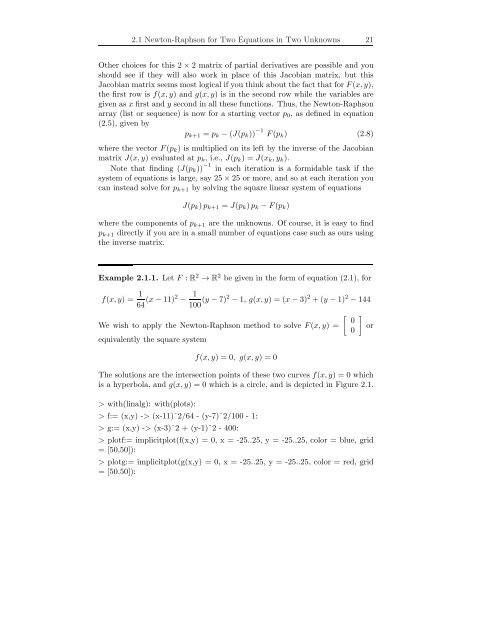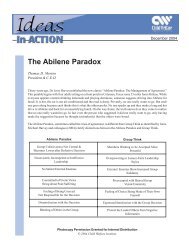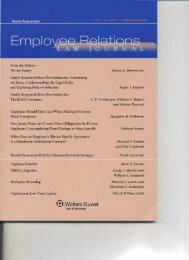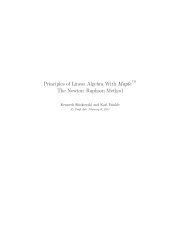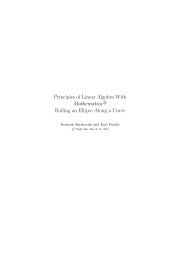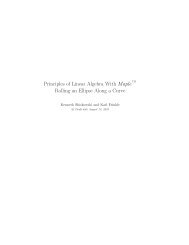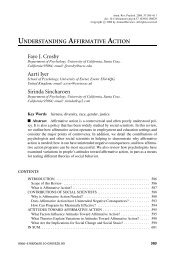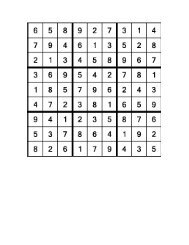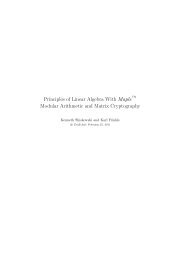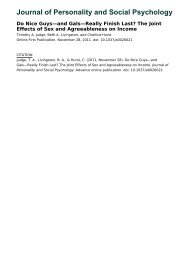Principles of Linear Algebra With Maple The NewtonâRaphson ...
Principles of Linear Algebra With Maple The NewtonâRaphson ...
Principles of Linear Algebra With Maple The NewtonâRaphson ...
- No tags were found...
Create successful ePaper yourself
Turn your PDF publications into a flip-book with our unique Google optimized e-Paper software.
2.1 Newton-Raphson for Two Equations in Two Unknowns 21Other choices for this 2×2 matrix <strong>of</strong> partial derivatives are possible and youshould see if they will also work in place <strong>of</strong> this Jacobian matrix, but thisJacobian matrix seems most logical if you think about the fact that for F(x,y),the first row is f(x,y) and g(x,y) is in the second row while the variables aregiven as x first and y second in all these functions. Thus, the Newton-Raphsonarray (list or sequence) is now for a starting vector p 0 , as defined in equation(2.5), given byp k+1 = p k −(J(p k )) −1 F(p k ) (2.8)where the vector F(p k ) is multiplied on its left by the inverse <strong>of</strong> the Jacobianmatrix J(x,y) evaluated at p k , i.e., J(p k ) = J(x k ,y k ).Note that finding (J(p k )) −1 in each iteration is a formidable task if thesystem <strong>of</strong> equations is large, say 25×25 or more, and so at each iteration youcan instead solve for p k+1 by solving the square linear system <strong>of</strong> equationsJ(p k )p k+1 = J(p k )p k −F(p k )where the components <strong>of</strong> p k+1 are the unknowns. Of course, it is easy to findp k+1 directly if you are in a small number <strong>of</strong> equations case such as ours usingthe inverse matrix.Example 2.1.1. Let F : R 2 → R 2 be given in the form <strong>of</strong> equation (2.1), forf(x,y) = 1 64 (x−11)2 − 1100 (y −7)2 −1, g(x,y) = (x−3) 2 +(y −1) 2 −144[ ] 0We wish to apply the Newton-Raphson method to solve F(x,y) = or0equivalently the square systemf(x,y) = 0, g(x,y) = 0<strong>The</strong> solutions are the intersection points <strong>of</strong> these two curves f(x,y) = 0 whichis a hyperbola, and g(x,y) = 0 which is a circle, and is depicted in Figure 2.1.> with(linalg): with(plots):> f:= (x,y) -> (x-11)ˆ2/64 - (y-7)ˆ2/100 - 1:> g:= (x,y) -> (x-3)ˆ2 + (y-1)ˆ2 - 400:> plotf:= implicitplot(f(x,y) = 0, x = -25..25, y = -25..25, color = blue, grid= [50,50]):> plotg:= implicitplot(g(x,y) = 0, x = -25..25, y = -25..25, color = red, grid= [50,50]):


